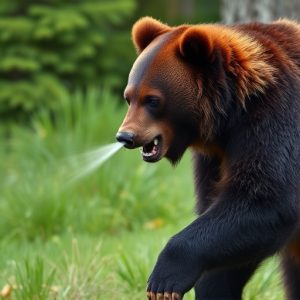Bear Pepper Spray Range: Safety Tips for Wilderness Encounters
Bear pepper spray, using capsaicin from chili peppers, temporarily disables bears through eye and re…….
Bear pepper spray, using capsaicin from chili peppers, temporarily disables bears through eye and respiratory irritation (3-6 meter range), with direct spraying into the bear's face offering the highest chance of immobilization. Effectiveness depends on factors like wind, angle, and the bear's reaction; maintaining distance and noise are primary preventive measures. While useful as a last resort, understanding variables affecting spray reach and employing alternative methods like noise and secure food storage are crucial for safety during bear encounters.
“Prepare for a wild encounter with our comprehensive guide on wilderness bear defense spray. Discover the effectiveness of bear pepper spray, understanding its range—up to 30 feet, depending on the brand—and how it can deter aggressive bears. Learn the application technique, essential safety precautions, and alternative measures to ensure your survival in remote areas. By mastering these skills, you’ll boost your chances of navigating encounters calmly and safely.”
- Understanding Bear Pepper Spray Effectiveness
- Application Technique and Range Considerations
- Safety Precautions and Alternative Measures
Understanding Bear Pepper Spray Effectiveness
Bear pepper spray is a popular defense mechanism for outdoor enthusiasts and hikers navigating wild areas known for bear populations. When it comes to understanding its effectiveness, knowledge is power. The spray’s primary active ingredient, capsaicin, is derived from chili peppers and targets the bear’s eyes, nose, and respiratory system. This irritates the mucous membranes, causing temporary blindness, coughing, and difficulty breathing.
The range at which bear pepper spray is effective can vary significantly. Manufacturers typically claim a reach of 3 to 6 meters (10-20 feet), but in reality, factors like wind, angle, and the bear’s initial reaction can influence its success. Proper application is crucial; spraying directly into the bear’s face offers the best chance of immobilizing it long enough for you to retreat safely. It’s important to note that while pepper spray can be a game-changer in close encounters, it should be used as a last resort when other preventive measures, like making noise and maintaining distance, have failed. In terms of how far it reaches, understanding these variables is key to ensuring your safety during potential bear encounters.
Application Technique and Range Considerations
The application technique for bear defense spray is crucial to its effectiveness. Unlike traditional pepper sprays designed for human self-defense, bear spray is formulated to create a large cloud of irritants when sprayed, aiming to disable the bear’s senses and provide an escape route. Users should point the nozzle towards the bear’s face and eyes, holding it approximately 20-30 feet (6-9 meters) away, ensuring a wide area is covered. A successful application creates a dense mist that lingers, allowing for a longer period of distraction and retreat.
The range of bear pepper spray is a critical consideration during encounters. While the exact distance can vary based on factors like wind and the spray’s formulation, it generally has an effective range of 20 to 35 feet (6 to 10 meters). This range allows users to create a safe barrier between themselves and the bear while providing enough time to retreat or seek shelter. It’s important to remember that bear spray is not a guarantee of safety; proper knowledge, distance maintenance, and awareness are equally vital components of bear encounter defense strategies.
Safety Precautions and Alternative Measures
When it comes to safety precautions, bear pepper spray is a valuable tool for outdoor enthusiasts and hikers navigating wilderness areas known for bear populations. However, understanding its range and effectiveness is paramount. The typical range of bear defense spray is around 3-4 meters (10-13 feet), which means users need to be within this distance to effectively apply the spray directly into the bear’s eyes and face. Exceeding this distance significantly reduces the spray’s impact.
Alternative measures, alongside using bear pepper spray, include making noise while hiking to deter bears, carrying bear bells, and ensuring food is stored securely in bear-resistant containers. Additionally, knowing local guidelines and bear behavior can help minimize encounters. Staying calm, assessing the situation, and following recommended protocols during a bear encounter are crucial skills for outdoor adventurers to ensure their safety in these natural environments.
When it comes to protecting yourself in a wilderness bear encounter, understanding the effectiveness of bear pepper spray and using it correctly can make a significant difference. It’s crucial to know that while bear pepper spray can be an effective defense, its range is limited, typically around 3-5 meters (10-15 feet). Proper application technique is key; aim for the bear’s face and eyes to maximize impact. However, remember that safety precautions go beyond just spray. Bear-resistant food storage, making noise during travel, and understanding local guidelines are alternative measures that should accompany any use of pepper spray. By combining these strategies, you enhance your chances of navigating potentially dangerous situations in the wilderness safely.


